最新微观经济学选择题100道答案
微观经济学试题库习题及答案解析

微观经济学试题库习题及答案解析一、选择题1. 在完全竞争市场中,厂商的边际收益曲线是一条()A. 向右上方倾斜的曲线B. 向右下方倾斜的曲线C. 水平线D. 向左上方倾斜的曲线答案:C解析:在完全竞争市场中,厂商是价格的接受者,边际收益等于市场价格,因此边际收益曲线是一条水平线。
2. 下列哪一项不是消费者剩余的来源?()A. 消费者愿意支付的价格高于市场价格B. 消费者购买商品的数量大于最优购买数量C. 消费者愿意支付的价格低于市场价格D. 消费者购买商品的数量小于最优购买数量答案:B解析:消费者剩余是指消费者愿意支付的价格与实际支付的价格之间的差额,因此选项A和C是正确的。
选项D也是正确的,因为消费者购买商品的数量小于最优购买数量时,消费者剩余会增加。
选项B 是错误的,因为消费者购买商品的数量大于最优购买数量时,消费者剩余会减少。
3. 在长期生产中,当劳动的边际产量开始下降时,劳动的平均产量()A. 仍然上升B. 开始下降C. 不变D. 无法确定答案:A解析:在长期生产中,劳动的边际产量开始下降时,劳动的平均产量仍然上升,因为平均产量是总产量除以劳动数量,而总产量在边际产量开始下降之前是增加的。
4. 下列哪一项不是完全竞争市场的特征?()A. 市场上有大量的买者和卖者B. 产品具有同质性C. 市场进入和退出自由D. 市场存在价格领导答案:D解析:完全竞争市场的特征包括:市场上有大量的买者和卖者、产品具有同质性、市场进入和退出自由。
市场不存在价格领导,因为价格是由市场供求关系决定的。
5. 下列哪一项不是规模经济的原因?()A. 专业化生产B. 技术进步C. 管理效率提高D. 市场垄断答案:D解析:规模经济的原因包括:专业化生产、技术进步、管理效率提高。
市场垄断不是规模经济的原因,因为垄断会导致市场效率降低。
二、简答题1. 简述边际效用递减规律。
答案:边际效用递减规律是指在其他条件不变的情况下,随着消费者对某种商品消费量的增加,每增加一单位消费量所获得的满足程度逐渐减少。
微观经济学mooc测试题及答案

微观经济学mooc测试题及答案一、选择题(每题2分,共10分)1. 微观经济学主要研究的是:A. 宏观经济现象B. 个体经济单位的行为C. 政府经济政策D. 国际经济关系答案:B2. 需求曲线通常表示为:A. 水平线B. 垂直线C. 下降线D. 上升线答案:C3. 边际效用递减原理指的是:A. 随着消费的增加,总效用增加B. 随着消费的增加,边际效用增加C. 随着消费的增加,边际效用减少D. 随着消费的增加,总效用减少答案:C4. 完全竞争市场的特征不包括:A. 产品同质化B. 买卖双方数量众多C. 买卖双方对价格有影响D. 没有进入和退出障碍答案:C5. 机会成本是指:A. 放弃的最低价值B. 放弃的最高价值C. 放弃的中间价值D. 放弃的任何价值答案:A二、判断题(每题1分,共5分)1. 价格弹性是衡量需求量对价格变化的敏感程度的指标。
(对)2. 边际成本在完全竞争市场中等于平均成本。
(对)3. 垄断市场下,企业的利润最大化产量是边际成本等于边际收益时的产量。
(对)4. 公共物品具有非排他性和非竞争性。
(对)5. 外部性是指个体经济单位在生产或消费活动中对第三方产生的非市场影响。
(对)三、简答题(每题5分,共10分)1. 什么是价格歧视?请举例说明。
答案:价格歧视是指同一产品或服务对不同消费者或不同购买数量收取不同价格的行为。
例如,电影院对学生和成人收取不同的票价。
2. 请解释什么是消费者剩余,并给出一个例子。
答案:消费者剩余是指消费者愿意支付的价格与实际支付价格之间的差额。
例如,如果一个人愿意为一杯咖啡支付5元,但实际上只支付了3元,那么他的消费者剩余就是2元。
四、计算题(每题10分,共20分)1. 假设某商品的供给函数为Qs = 10P,需求函数为Qd = 50 - 2P,求市场均衡价格和均衡数量。
答案:将供给函数和需求函数相等,即10P = 50 - 2P,解得P = 4。
将P代入任一函数求得Q,Q = 50 - 2*4 = 42。
微观经济学考试题及答案

微观经济学考试题及答案一、单项选择题(每题2分,共20分)1. 需求弹性的计算公式是:A. 需求量的变化百分比 / 价格的变化百分比B. 价格的变化百分比 / 需求量的变化百分比C. 需求量的变化百分比 / 收入的变化百分比D. 收入的变化百分比 / 需求量的变化百分比答案:A2. 完全竞争市场中,企业在短期内实现利润最大化的条件是:A. MR = MCB. MR = ACC. MR = ARD. MR = AVC答案:A3. 价格歧视的类型不包括:A. 一级价格歧视B. 二级价格歧视C. 三级价格歧视D. 四级价格歧视答案:D4. 边际成本曲线与平均成本曲线的交点表示:A. 企业利润最大化的产量B. 企业亏损最小的产量C. 企业成本最低的产量D. 企业产量变化的转折点答案:C5. 以下哪项不是外部性的表现形式:A. 正外部性B. 负外部性C. 内部性D. 外部性答案:C6. 消费者剩余是指:A. 消费者愿意支付的最高价格与市场价格之间的差额B. 消费者实际支付的价格与市场价格之间的差额C. 消费者愿意支付的最高价格与实际支付的价格之间的差额D. 市场价格与消费者实际支付的价格之间的差额答案:A7. 洛伦兹曲线是衡量:A. 收入分配的公平性B. 收入分配的效率C. 收入分配的稳定性D. 收入分配的波动性答案:A8. 以下哪项不是公共物品的特征:A. 非竞争性B. 非排他性C. 可分割性D. 非盈利性答案:C9. 供给曲线向右下方倾斜的原因是:A. 价格上升,供给量增加B. 价格下降,供给量减少C. 价格上升,供给量减少D. 价格下降,供给量增加答案:A10. 以下哪项不是影响需求的因素:A. 消费者偏好B. 消费者收入C. 生产成本D. 替代品价格答案:C二、简答题(每题10分,共30分)1. 简述边际效用递减规律的含义及其对消费者选择的影响。
答案:边际效用递减规律指的是随着消费某种商品的数量增加,从每增加一单位商品中获得的额外满足(即边际效用)逐渐减少。
《微观经济学》练习题答案(全)
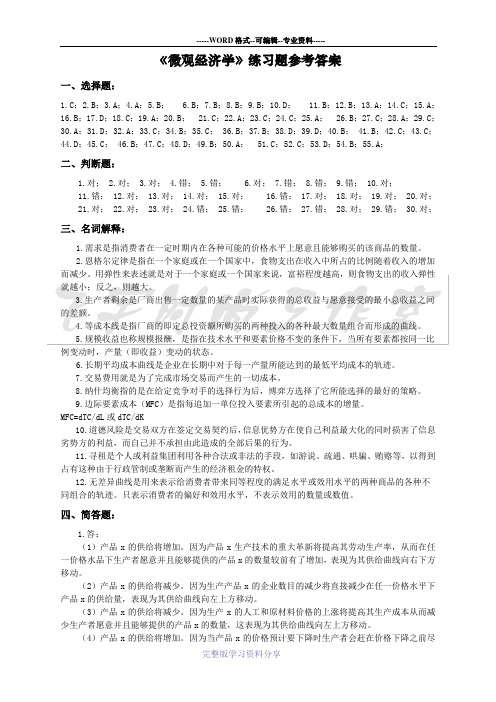
《微观经济学》练习题参考答案一、选择题:1.C;2.B;3.A;4.A;5.B;6.B;7.B;8.B;9.B;10.D; 11.B;12.B;13.A;14.C;15.A;16.B;17.D;18.C;19.A;20.B; 21.C;22.A;23.C;24.C;25.A; 26.B;27.C;28.A;29.C;30.A;31.D;32.A;33.C;34.B;35.C; 36.B;37.B;38.D;39.D;40.B; 41.B;42.C;43.C;44.D;45.C; 46.B;47.C;48.D;49.B;50.A; 51.C;52.C;53.D;54.B;55.A;二、判断题:1.对;2.对;3.对;4.错;5.错;6.对;7.错;8.错;9.错; 10.对;11.错; 12.对; 13.对; 14.对; 15.对; 16.错; 17.对; 18.对; 19.对; 20.对;21.对; 22.对; 23.对; 24.错; 25.错; 26.错; 27.错; 28.对; 29.错; 30.对;三、名词解释:1.需求是指消费者在一定时期内在各种可能的价格水平上愿意且能够购买的该商品的数量。
2.恩格尔定律是指在一个家庭或在一个国家中,食物支出在收入中所占的比例随着收入的增加而减少。
用弹性来表述就是对于一个家庭或一个国家来说,富裕程度越高,则食物支出的收入弹性就越小;反之,则越大。
3.生产者剩余是厂商出售一定数量的某产品时实际获得的总收益与愿意接受的最小总收益之间的差额。
4.等成本线是指厂商的即定总投资额所购买的两种投入的各种最大数量组合而形成的曲线。
5.规模收益也称规模报酬,是指在技术水平和要素价格不变的条件下,当所有要素都按同一比例变动时,产量(即收益)变动的状态。
6.长期平均成本曲线是企业在长期中对于每一产量所能达到的最低平均成本的轨迹。
7.交易费用就是为了完成市场交易而产生的一切成本。
微观经济学考试题含参考答案
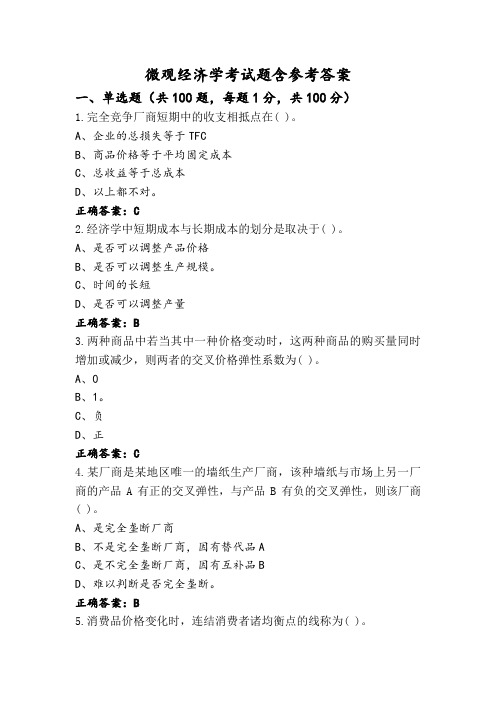
微观经济学考试题含参考答案一、单选题(共100题,每题1分,共100分)1.完全竞争厂商短期中的收支相抵点在( )。
A、企业的总损失等于TFCB、商品价格等于平均固定成本C、总收益等于总成本D、以上都不对。
正确答案:C2.经济学中短期成本与长期成本的划分是取决于( )。
A、是否可以调整产品价格B、是否可以调整生产规模。
C、时间的长短D、是否可以调整产量正确答案:B3.两种商品中若当其中一种价格变动时,这两种商品的购买量同时增加或减少,则两者的交叉价格弹性系数为( )。
A、0B、1。
C、负D、正正确答案:C4.某厂商是某地区唯一的墙纸生产厂商,该种墙纸与市场上另一厂商的产品A有正的交叉弹性,与产品B有负的交叉弹性,则该厂商( )。
A、是完全垄断厂商B、不是完全垄断厂商,因有替代品AC、是不完全垄断厂商,因有互补品BD、难以判断是否完全垄断。
正确答案:B5.消费品价格变化时,连结消费者诸均衡点的线称为( )。
A、恩格尔曲线。
B、需求曲线C、价格—消费曲线,D、收入—消费曲线正确答案:C6.正常物品价格上升导致需求量减少的原因在于( )。
A、替代效应使需求量增加,收入效应使需求量减少B、替代效应使需求量增加,收入效应使需求量增加C、替代效应使需求量减少,收入效应使需求量减少D、替代效应使需求量减少,收入效应使需求量增加。
正确答案:C答案解析:正常物品价格上升,会导致消费者购买力下降,从而减少需求量。
这是收入效应的表现。
同时,价格上升也会使得替代物品相对更具吸引力,从而增加替代效应,进一步减少需求量。
因此,选项C是正确的。
7.对完全垄断厂商来说( )。
A、提高价格一定能增加收益B、降低价格一定会减少收益C、提高价格未必能增加收益,降低价格未必能减少收益D、以上都不正确。
正确答案:C答案解析:对完全垄断厂商来说,其面临的市场需求曲线是其唯一的边际收益曲线。
因此,提高价格会导致销量下降,但每个单位的售价会增加,从而可能增加收益;降低价格会导致销量增加,但每个单位的售价会减少,从而可能减少收益。
微观经济学试题及答案解析
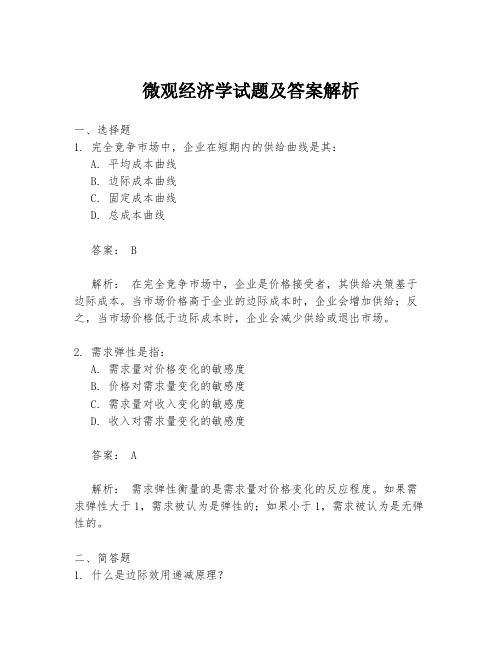
微观经济学试题及答案解析一、选择题1. 完全竞争市场中,企业在短期内的供给曲线是其:A. 平均成本曲线B. 边际成本曲线C. 固定成本曲线D. 总成本曲线答案: B解析:在完全竞争市场中,企业是价格接受者,其供给决策基于边际成本。
当市场价格高于企业的边际成本时,企业会增加供给;反之,当市场价格低于边际成本时,企业会减少供给或退出市场。
2. 需求弹性是指:A. 需求量对价格变化的敏感度B. 价格对需求量变化的敏感度C. 需求量对收入变化的敏感度D. 收入对需求量变化的敏感度答案: A解析:需求弹性衡量的是需求量对价格变化的反应程度。
如果需求弹性大于1,需求被认为是弹性的;如果小于1,需求被认为是无弹性的。
二、简答题1. 什么是边际效用递减原理?答案:边际效用递减原理指的是随着消费者消费某一商品的数量增加,每增加一个单位商品所带来的额外满足感(边际效用)逐渐减少的现象。
2. 什么是价格歧视?请简述其类型。
答案:价格歧视是指同一商品或服务对不同消费者或在不同时间、地点以不同价格出售的行为。
其类型包括:一级价格歧视(对每个消费者都收取其愿意支付的最高价格)、二级价格歧视(对不同数量的购买收取不同价格)、三级价格歧视(对不同市场或消费者群体收取不同价格)。
三、计算题1. 假设一个完全竞争企业的总成本函数为TC = 0.5Q^2 + 2Q + 10,其中Q是产量。
求该企业在市场价格P=5时的最优产量。
答案:首先,计算边际成本(MC):MC = d(TC)/dQ = Q + 2。
当市场价格P=5时,企业将生产到MC=P,即5=Q+2,解得Q=3。
解析:企业在市场价格等于其边际成本时达到最优产量,因为此时企业无法通过增加或减少产量来增加利润。
四、论述题1. 论述市场失灵的原因及其对经济的影响。
答案:市场失灵是指市场机制不能有效地分配资源,导致资源配置效率低下。
原因包括外部性、公共品、信息不对称、垄断等。
市场失灵会导致资源浪费、收入分配不公、消费者和生产者剩余减少等经济问题。
微观经济学选择题(答案已修正均为正确答案)
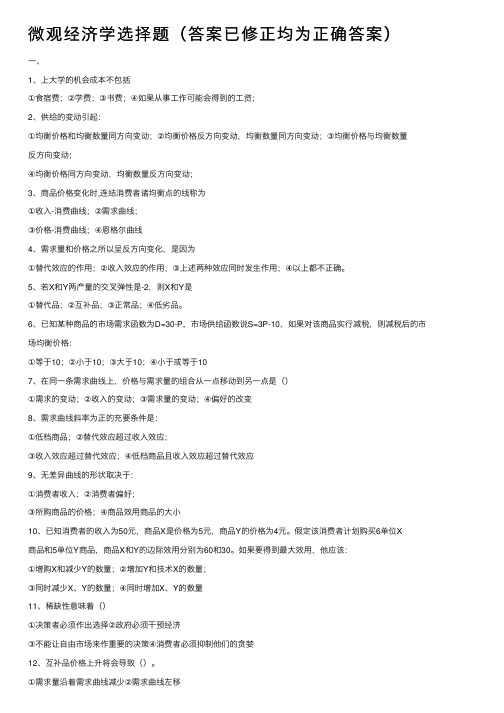
微观经济学选择题(答案已修正均为正确答案)⼀、1、上⼤学的机会成本不包括①⾷宿费;②学费;③书费;④如果从事⼯作可能会得到的⼯资;2、供给的变动引起:①均衡价格和均衡数量同⽅向变动;②均衡价格反⽅向变动,均衡数量同⽅向变动;③均衡价格与均衡数量反⽅向变动;④均衡价格同⽅向变动,均衡数量反⽅向变动;3、商品价格变化时,连结消费者诸均衡点的线称为①收⼊-消费曲线;②需求曲线;③价格-消费曲线;④恩格尔曲线4、需求量和价格之所以呈反⽅向变化,是因为①替代效应的作⽤;②收⼊效应的作⽤;③上述两种效应同时发⽣作⽤;④以上都不正确。
5、若X和Y两产量的交叉弹性是-2,则X和Y是①替代品;②互补品;③正常品;④低劣品。
6、已知某种商品的市场需求函数为D=30-P,市场供给函数说S=3P-10,如果对该商品实⾏减税,则减税后的市场均衡价格:①等于10;②⼩于10;③⼤于10;④⼩于或等于107、在同⼀条需求曲线上,价格与需求量的组合从⼀点移动到另⼀点是()①需求的变动;②收⼊的变动;③需求量的变动;④偏好的改变8、需求曲线斜率为正的充要条件是:①低档商品;②替代效应超过收⼊效应;③收⼊效应超过替代效应;④低档商品且收⼊效应超过替代效应9、⽆差异曲线的形状取决于:①消费者收⼊;②消费者偏好;③所购商品的价格;④商品效⽤商品的⼤⼩10、已知消费者的收⼊为50元,商品X是价格为5元,商品Y的价格为4元。
假定该消费者计划购买6单位X商品和5单位Y商品,商品X和Y的边际效⽤分别为60和30。
如果要得到最⼤效⽤,他应该:①增购X和减少Y的数量;②增加Y和技术X的数量;③同时减少X、Y的数量;④同时增加X、Y的数量11、稀缺性意味着()①决策者必须作出选择②政府必须⼲预经济③不能让⾃由市场来作重要的决策④消费者必须抑制他们的贪婪12、互补品价格上升将会导致()。
①需求量沿着需求曲线减少②需求曲线左移③个⼈增加他所消费的所有商品的数量④需求量沿着需求曲线增加13、假如增加⼀单位产量所带来的边际成本⼤于产量增加前的平均变动成本,那么在产量增加后平均变动成本:①减少;②增加;③不变;④都有可能14、如果⼀条商品的恩格尔曲线是通过原点的⼀条直线,则这种商品的需求收⼊弹性()①⼤于1;②⼩于1;③等于1;④等于零;15、如果在⼚商的短期均衡产量上,AR⼩于SAC,但⼤于A VC,则⼚商①亏损,⽴即停产;②亏损,但继续⽣产;③亏损,⽣产或不⽣产都可以;④获得正常利润,继续⽣产;16、在⾃然垄断中,边际成本:①等于价格②等于平均成本③⼩于平均成本④⼤于平均成本17、若管理机构对垄断⼚商的限价正好使其经济利润消失, 价格要等于①边际收益;②边际成本;③平均成本;④平均可变成本18、当某种产品的⽣产存在外部不经济时:①社会边际成本⼩于私⼈边际成本;②社会边际成本⼤于私⼈边际成本;③产品供给不⾜;④太少资源被分配给该产品的⽣产19、在完全竞争市场上,⼚商对⽣产要素的需求量取决于①消费者对该要素⽣产的产品的需求;②产品市场的价格;③要素的边际产量;④⽣产要素的价格。
微观经济学试题及答案

微观经济学试题及答案一、名词解释(每题3分,共12分)1. 需求曲线2. 边际效用3. 完全竞争市场4. 外部性5. 生产可能性边界二、选择题(每题2分,共10分)1. 在完全竞争市场中,厂商的利润最大化的条件是()A. P=AR=MRB. P=ARC. P=MRD. P=MC2. 以下哪个因素不属于影响供给的因素?()A. 技术水平B. 生产成本C. 消费者偏好D. 价格3. 某商品的需求价格为5元,供给价格为8元,如果政府对该商品实施价格干预,设定价格为6元,则会导致()A. 市场需求量增加,市场供给量减少B. 市场需求量减少,市场供给量增加C. 市场需求量增加,市场供给量不变D. 市场需求量减少,市场供给量不变4. 下列哪个市场结构中,企业数量最多?()A. 完全竞争市场B. 垄断市场C. 寡头垄断市场D. 完全垄断市场5. 某厂商生产两种产品,生产第一种产品的边际成本是4元,生产第二种产品的边际成本是6元。
如果厂商的目标是利润最大化,那么,厂商应该()A. 增加第一种产品的生产B. 增加第二种产品的生产C. 减少第一种产品的生产D. 减少第二种产品的生产三、简答题(每题5分,共20分)1. 请简述微观经济学研究的基本问题。
2. 请简述需求定理和供给定理。
3. 请简述完全竞争市场和完全垄断市场的特点。
4. 请简述外部性对经济的影响。
四、论述题(每题10分,共20分)1. 请论述价格弹性对厂商定价策略的影响。
2. 请论述微观经济学中市场竞争对资源配置的作用。
五、案例分析题(22分)某城市有两家公交公司A和B,它们在该城市公交市场上相互竞争。
A公司拥有30辆公交车,B公司拥有20辆公交车。
两家公司的公交车票价均为1元。
最近,A公司决定降低票价至0.8元,以吸引更多乘客。
假设其他条件不变,请分析以下问题:1. 请用微观经济学知识解释A公司降低票价的动机。
2. 请分析B公司可能的应对策略。
3. 假设降低票价后,A公司的乘客数量增加了20%,而B公司的乘客数量减少了10%。
微观经济学选择模拟考试题(含答案)
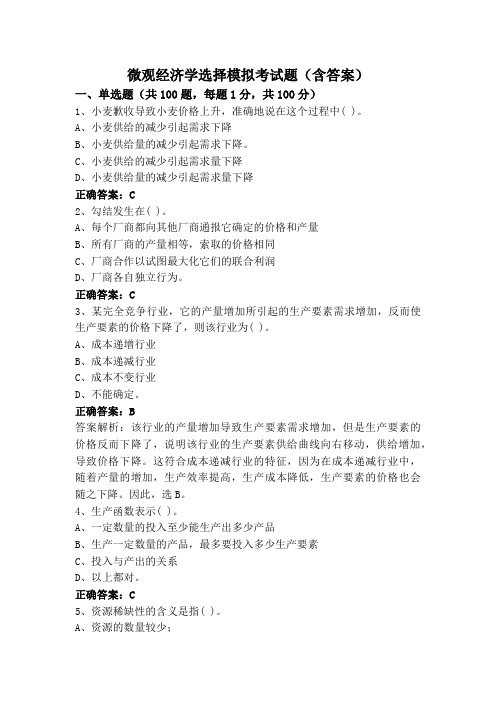
微观经济学选择模拟考试题(含答案)一、单选题(共100题,每题1分,共100分)1、小麦歉收导致小麦价格上升,准确地说在这个过程中( )。
A、小麦供给的减少引起需求下降B、小麦供给量的减少引起需求下降。
C、小麦供给的减少引起需求量下降D、小麦供给量的减少引起需求量下降正确答案:C2、勾结发生在( )。
A、每个厂商都向其他厂商通报它确定的价格和产量B、所有厂商的产量相等,索取的价格相同C、厂商合作以试图最大化它们的联合利润D、厂商各自独立行为。
正确答案:C3、某完全竞争行业,它的产量增加所引起的生产要素需求增加,反而使生产要素的价格下降了,则该行业为( )。
A、成本递增行业B、成本递减行业C、成本不变行业D、不能确定。
正确答案:B答案解析:该行业的产量增加导致生产要素需求增加,但是生产要素的价格反而下降了,说明该行业的生产要素供给曲线向右移动,供给增加,导致价格下降。
这符合成本递减行业的特征,因为在成本递减行业中,随着产量的增加,生产效率提高,生产成本降低,生产要素的价格也会随之下降。
因此,选B。
4、生产函数表示( )。
A、一定数量的投入至少能生产出多少产品B、生产一定数量的产品,最多要投入多少生产要素C、投入与产出的关系D、以上都对。
正确答案:C5、资源稀缺性的含义是指( )。
A、资源的数量较少;B、获得一定量资源所必须耗费的成本相当高;C、资源的价格很高。
D、相对于人类无限的欲望来说,再多的资源也显不足;正确答案:D6、若x和y两产品的交叉弹性是-2,则( )。
A、x和y是替代品B、x和y是正常商品C、x和y是互补品。
D、x和y是劣质品正确答案:C7、需求曲线斜率为正的充要条件是( )。
A、收入效应超过替代效应B、替代效应超过收入效应C、低档商品且收入效应超过替代效应。
D、低档商品正确答案:C8、当某消费者对商品X的消费达到饱和点时,则边际效用MUX为( )。
A、不确定,需视具体情况而定。
B、零C、负值D、正值正确答案:B9、垄断企业面对的需求函数为Q=100/ P2,企业的边际成本始终为1,垄断价格为( )。
微观经济学试题及答案
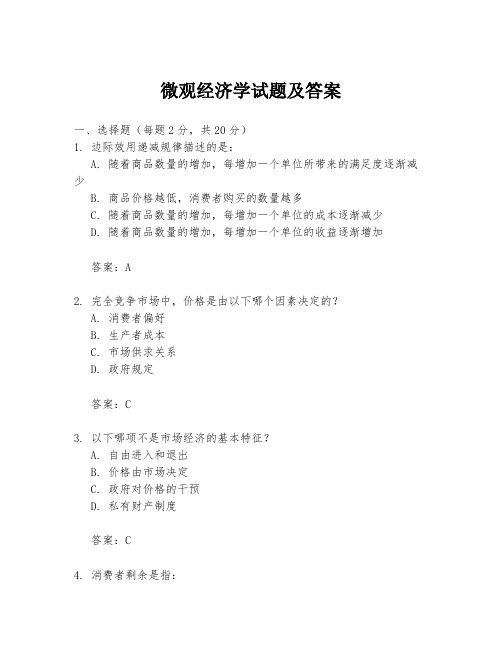
微观经济学试题及答案一、选择题(每题2分,共20分)1. 边际效用递减规律描述的是:A. 随着商品数量的增加,每增加一个单位所带来的满足度逐渐减少B. 商品价格越低,消费者购买的数量越多C. 随着商品数量的增加,每增加一个单位的成本逐渐减少D. 随着商品数量的增加,每增加一个单位的收益逐渐增加答案:A2. 完全竞争市场中,价格是由以下哪个因素决定的?A. 消费者偏好B. 生产者成本C. 市场供求关系D. 政府规定答案:C3. 以下哪项不是市场经济的基本特征?A. 自由进入和退出B. 价格由市场决定C. 政府对价格的干预D. 私有财产制度答案:C4. 消费者剩余是指:A. 消费者购买商品支付的价格B. 消费者购买商品获得的总效用C. 消费者愿意支付的价格与实际支付价格之间的差额D. 消费者购买商品的成本答案:C5. 以下哪种情况会导致需求曲线向右移动?A. 商品价格上升B. 消费者收入增加C. 商品价格下降D. 消费者收入减少答案:B6. 以下哪项不是影响供给的因素?A. 生产成本B. 消费者偏好C. 技术水平D. 相关商品的价格答案:B7. 垄断市场中,厂商的定价策略通常会导致:A. 市场价格低于边际成本B. 市场价格高于边际成本C. 市场价格等于边际成本D. 市场价格与边际成本无关答案:B8. 以下哪种情况会导致供给曲线向左移动?A. 生产成本上升B. 消费者需求增加C. 技术水平提高D. 政府补贴增加答案:A9. 价格弹性的定义是:A. 需求量对价格变化的敏感程度B. 供给量对价格变化的敏感程度C. 需求量对收入变化的敏感程度D. 供给量对成本变化的敏感程度答案:A10. 以下哪项不是市场失灵的原因?A. 外部性B. 公共品C. 完全竞争D. 信息不对称答案:C二、简答题(每题10分,共30分)1. 简述完全竞争市场的特点。
答案:完全竞争市场的特点包括:市场上存在大量买家和卖家,产品是同质的,市场信息完全透明,进入和退出市场没有障碍,没有交易成本,不存在政府干预。
微观经济学考试题库及答案
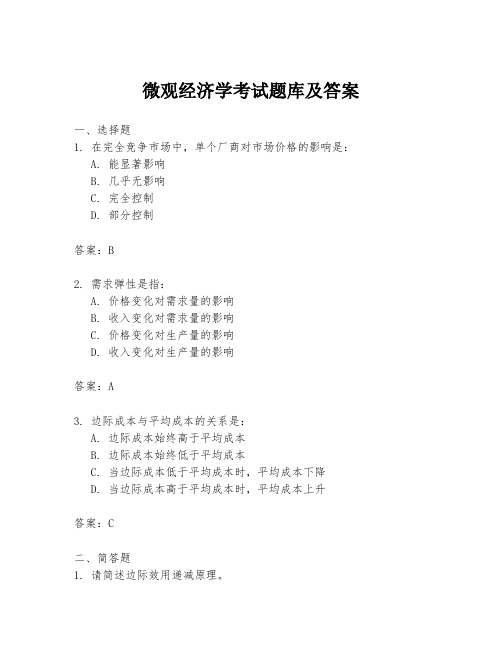
微观经济学考试题库及答案一、选择题1. 在完全竞争市场中,单个厂商对市场价格的影响是:A. 能显著影响B. 几乎无影响C. 完全控制D. 部分控制答案:B2. 需求弹性是指:A. 价格变化对需求量的影响B. 收入变化对需求量的影响C. 价格变化对生产量的影响D. 收入变化对生产量的影响答案:A3. 边际成本与平均成本的关系是:A. 边际成本始终高于平均成本B. 边际成本始终低于平均成本C. 当边际成本低于平均成本时,平均成本下降D. 当边际成本高于平均成本时,平均成本上升答案:C二、简答题1. 请简述边际效用递减原理。
答案:边际效用递减原理指的是,随着消费者对某种商品的消费量增加,每增加一单位商品所带来的额外满足感(即边际效用)会逐渐减少。
2. 什么是机会成本?答案:机会成本是指为了获取某种资源或进行某种活动而放弃的其他选择中价值最高的那个选择的成本。
三、计算题1. 假设某公司生产商品的总成本函数为TC(q) = 10q + 0.5q^2,求该公司生产10件商品的平均成本和边际成本。
答案:首先计算总成本TC(10) = 10*10 + 0.5*10^2 = 100 + 50 = 150。
平均成本AC(10) = TC(10)/10 = 150/10 = 15。
边际成本MC(10) = dTC/dq | q=10 = 10 + 0.5*2*10 = 10 + 10 = 20。
四、论述题1. 论述市场失灵的原因及其可能的解决措施。
答案:市场失灵可能由多种原因引起,包括外部性、公共品、信息不对称、垄断等。
解决措施可以包括政府干预,如征税、补贴、提供公共品、反垄断法规等。
结束语:以上是微观经济学考试题库及答案的示例。
希望这些题目和答案能够帮助学生更好地理解和掌握微观经济学的基本概念和原理。
在实际考试中,题目可能会有所不同,但基本概念和分析方法是相通的。
祝大家考试顺利!。
微观经济学试题及参考答案大全
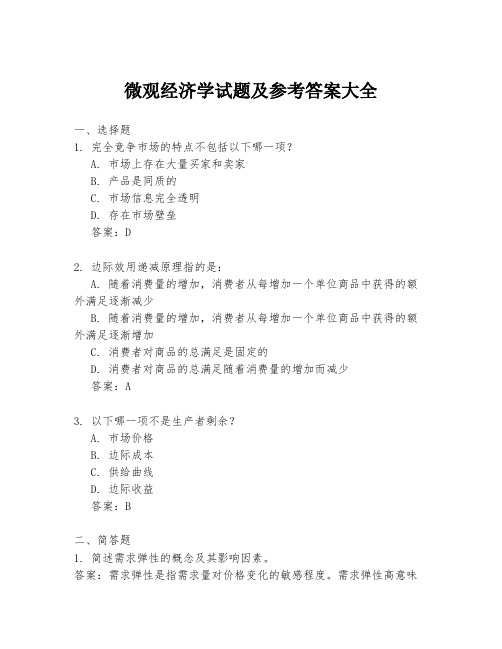
微观经济学试题及参考答案大全一、选择题1. 完全竞争市场的特点不包括以下哪一项?A. 市场上存在大量买家和卖家B. 产品是同质的C. 市场信息完全透明D. 存在市场壁垒答案:D2. 边际效用递减原理指的是:A. 随着消费量的增加,消费者从每增加一个单位商品中获得的额外满足逐渐减少B. 随着消费量的增加,消费者从每增加一个单位商品中获得的额外满足逐渐增加C. 消费者对商品的总满足是固定的D. 消费者对商品的总满足随着消费量的增加而减少答案:A3. 以下哪一项不是生产者剩余?A. 市场价格B. 边际成本C. 供给曲线D. 边际收益答案:B二、简答题1. 简述需求弹性的概念及其影响因素。
答案:需求弹性是指需求量对价格变化的敏感程度。
需求弹性高意味着价格的小幅变动会导致需求量的大幅变动。
影响需求弹性的因素包括商品的替代品数量、商品的必需品程度、消费者的收入水平、商品的用途多样性等。
2. 什么是边际成本和平均成本?它们之间的关系是什么?答案:边际成本是指生产额外一单位产品所增加的总成本。
平均成本是指生产单位产品的平均成本,等于总成本除以生产量。
边际成本与平均成本之间的关系是:当边际成本低于平均成本时,平均成本会下降;当边际成本高于平均成本时,平均成本会上升。
三、计算题1. 假设某公司生产函数为Q = 2L^(1/2)K^(1/3),其中Q是产量,L 是劳动投入,K是资本投入。
如果劳动投入L=4,资本投入K=27,求该公司的产量Q。
答案:将L=4和K=27代入生产函数Q = 2L^(1/2)K^(1/3),得到Q = 2 * (4)^(1/2) * (27)^(1/3) = 2 * 2 * 3 = 12。
2. 假设某商品的市场需求函数为Qd = 100 - 2P,供给函数为Qs = 5P。
求市场均衡价格和数量。
答案:市场均衡时,需求量等于供给量,即Qd = Qs。
将需求函数和供给函数相等,得到100 - 2P = 5P,解得P = 16。
微观经济学试题及答案
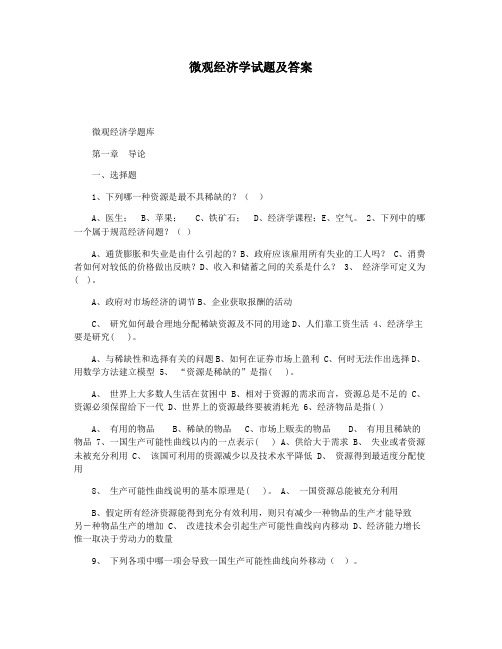
微观经济学试题及答案微观经济学题库第一章导论一、选择题1、下列哪一种资源是最不具稀缺的?()A、医生;B、苹果;C、铁矿石;D、经济学课程;E、空气。
2、下列中的哪一个属于规范经济问题?()A、通货膨胀和失业是由什么引起的?B、政府应该雇用所有失业的工人吗?C、消费者如何对较低的价格做出反映?D、收入和储蓄之间的关系是什么? 3、经济学可定义为( )。
A、政府对市场经济的调节B、企业获取报酬的活动C、研究如何最合理地分配稀缺资源及不同的用途D、人们靠工资生活 4、经济学主要是研究( )。
A、与稀缺性和选择有关的问题B、如何在证券市场上盈利C、何时无法作出选择D、用数学方法建立模型 5、“资源是稀缺的”是指( )。
A、世界上大多数人生活在贫困中B、相对于资源的需求而言,资源总是不足的C、资源必须保留给下一代D、世界上的资源最终要被消耗光 6、经济物品是指( )A、有用的物品B、稀缺的物品C、市场上贩卖的物品D、有用且稀缺的物品 7、一国生产可能性曲线以内的一点表示( ) A、供给大于需求 B、失业或者资源未被充分利用 C、该国可利用的资源减少以及技术水平降低 D、资源得到最适度分配使用8、生产可能性曲线说明的基本原理是( )。
A、一国资源总能被充分利用B、假定所有经济资源能得到充分有效利用,则只有减少一种物品的生产才能导致另―种物品生产的增加C、改进技术会引起生产可能性曲线向内移动D、经济能力增长惟一取决于劳动力的数量9、下列各项中哪一项会导致一国生产可能性曲线向外移动()。
A、失业B、通货紧缩C、资源增加或者技术进步D、消费品生产减少,资本品生产下降 10、经济学研究的基本问题是( )。
A、怎样生产B、生产什么,生产多少C、为谁生产D、以上都包括 11、下列命题中哪一个不是实证经济学命题( )。
A、 1982年8月美联储把贴现率降到10% B、1981年失业率超过9%C、联邦所得税对中等收入家庭是不公平的D、社会保险税的课税依据现己超过30000美元 12、微观经济学所要论证的根本思想或目的是 A、一般均衡论 B、“看不见的手”的原理 C、整个资本主义经济可以实现有效率的资源配置 D、完全竞争市场下可以实现帕累托最优二、简答题1、什么是西方经济学?2、试述西方经济学企图解决的两个问题及两重属性。
微观经济学试题库含参考答案
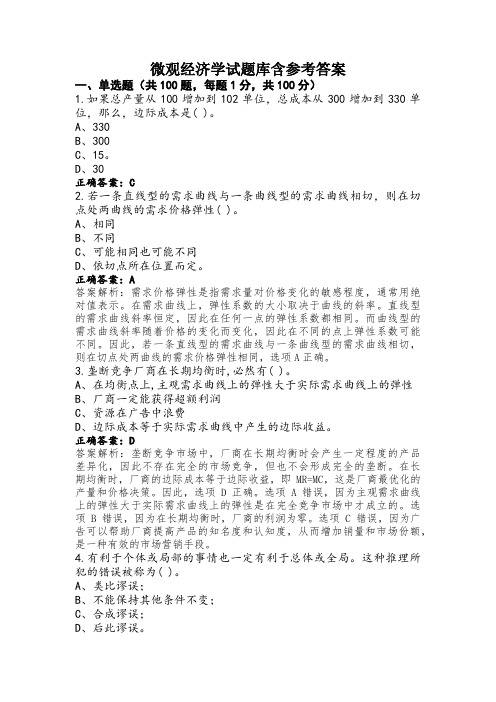
微观经济学试题库含参考答案一、单选题(共100题,每题1分,共100分)1.如果总产量从100增加到102单位,总成本从300增加到330单位,那么,边际成本是( )。
A、330B、300C、15。
D、30正确答案:C2.若一条直线型的需求曲线与一条曲线型的需求曲线相切,则在切点处两曲线的需求价格弹性( )。
A、相同B、不同C、可能相同也可能不同D、依切点所在位置而定。
正确答案:A答案解析:需求价格弹性是指需求量对价格变化的敏感程度,通常用绝对值表示。
在需求曲线上,弹性系数的大小取决于曲线的斜率。
直线型的需求曲线斜率恒定,因此在任何一点的弹性系数都相同。
而曲线型的需求曲线斜率随着价格的变化而变化,因此在不同的点上弹性系数可能不同。
因此,若一条直线型的需求曲线与一条曲线型的需求曲线相切,则在切点处两曲线的需求价格弹性相同,选项A正确。
3.垄断竞争厂商在长期均衡时,必然有( )。
A、在均衡点上,主观需求曲线上的弹性大于实际需求曲线上的弹性B、厂商一定能获得超额利润C、资源在广告中浪费D、边际成本等于实际需求曲线中产生的边际收益。
正确答案:D答案解析:垄断竞争市场中,厂商在长期均衡时会产生一定程度的产品差异化,因此不存在完全的市场竞争,但也不会形成完全的垄断。
在长期均衡时,厂商的边际成本等于边际收益,即MR=MC,这是厂商最优化的产量和价格决策。
因此,选项D正确。
选项A错误,因为主观需求曲线上的弹性大于实际需求曲线上的弹性是在完全竞争市场中才成立的。
选项B错误,因为在长期均衡时,厂商的利润为零。
选项C错误,因为广告可以帮助厂商提高产品的知名度和认知度,从而增加销量和市场份额,是一种有效的市场营销手段。
4.有利于个体或局部的事情也一定有利于总体或全局。
这种推理所犯的错误被称为( )。
A、类比谬误;B、不能保持其他条件不变;C、合成谬误;D、后此谬误。
5.会计利润等于总收益减( )。
A、显性成本B、边际成本。
微观经济学试题及答案
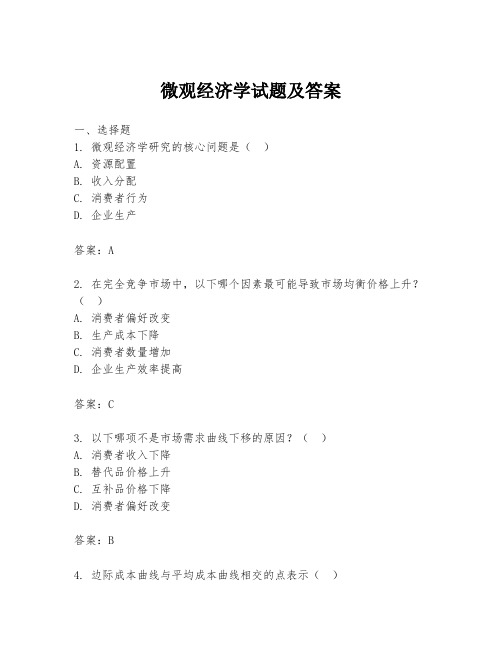
微观经济学试题及答案一、选择题1. 微观经济学研究的核心问题是()A. 资源配置B. 收入分配C. 消费者行为D. 企业生产答案:A2. 在完全竞争市场中,以下哪个因素最可能导致市场均衡价格上升?()A. 消费者偏好改变B. 生产成本下降C. 消费者数量增加D. 企业生产效率提高答案:C3. 以下哪项不是市场需求曲线下移的原因?()A. 消费者收入下降B. 替代品价格上升C. 互补品价格下降D. 消费者偏好改变答案:B4. 边际成本曲线与平均成本曲线相交的点表示()A. 企业亏损B. 企业盈利C. 企业生产最小化D. 企业生产最大化答案:B5. 如果一家公司的边际收益递减,那么()A. 总收益递增但增速放缓B. 总收益递减C. 边际成本递增D. 平均成本递减答案:A二、填空题1. 在微观经济学中,________是指在其他条件不变的情况下,一种商品价格变动所引起的该商品需求量变动的百分比与价格变动的百分比之比。
答案:价格弹性2. 当_________存在时,企业可以通过增加产量来降低单位成本。
答案:规模经济3. 在市场经济中,_________是指消费者愿意并且能够购买的商品或服务的数量。
答案:需求4. 微观经济学中的_________理论解释了企业如何决定生产多少商品以及如何定价。
答案:利润最大化5. 当市场上只有一个买家和多个卖家时,这种市场结构被称为_________。
答案:单买寡卖三、简答题1. 简述需求定律的内容及其在市场经济中的作用。
答案:需求定律指出,在其他条件不变的情况下,商品的价格与其需求量成反比,即价格上升时需求量下降,价格下降时需求量上升。
这一定律在市场经济中的作用主要体现在帮助生产者和消费者做出决策,如调整生产量和定价策略,以及预测市场变化等。
2. 描述边际成本与平均成本之间的关系。
答案:边际成本是指生产额外一单位产品所增加的成本,而平均成本是指单位产品的平均成本。
在生产过程中,随着产量的增加,边际成本会先降低后上升,这是因为规模经济效应使得单位成本降低,但当超过某一点后,由于拥挤效应等因素,单位成本会上升。
微观经济学考试题+参考答案

微观经济学考试题+参考答案一、单选题(共100题,每题1分,共100分)1.某完全竞争厂商的销售量Q=10,单价P=8,其总变动成本为60,则生产者剩余为( )。
A、20B、140。
C、60D、80正确答案:A2.边际成本低于平均成本时,( )。
A、平均成本上升B、平均可变成本可能上升也可能上升也可能下降C、总成本下降D、平均可变成本上升。
正确答案:B答案解析:当边际成本低于平均成本时,说明新增生产的单位成本低于平均成本,这可能是因为新增生产的单位产量较少,而固定成本已经分摊到之前的产量中,因此平均成本会上升。
但是,新增生产的单位成本低于平均成本,说明新增生产的单位可变成本也低于平均可变成本,因此平均可变成本可能上升也可能下降。
总成本下降的情况不太可能出现,因为新增生产的单位成本低于平均成本,但是总成本仍然包括之前的固定成本,因此总成本不太可能下降。
因此,选项B是正确的。
3.经济学中短期成本与长期成本的划分是取决于( )。
A、时间的长短B、是否可以调整生产规模。
C、是否可以调整产品价格D、是否可以调整产量正确答案:B4.某消费者消费A、B两种商品,假定消费者的收入增加了一倍,同时两种商品的价格也提高了一倍,该消费者的预算线将( )。
A、向外平移但斜率不变B、向外移动但更陡峭C、向外移动但更平缓D、不变。
正确答案:D5.已知消费者的收入是lOO元,商品X的价格是10元,商品Y的价格是3元。
假定他打算购买7单位X和10单位Y,这时商品X和Y的边际效用分别是50和18。
如要获得最大效用,他应该( )。
A、同时增购X和Y。
B、增购X、减少Y的购买量C、停止购买D、减少X的购买量,增购Y正确答案:D6.垄断企业面对的需求函数为Q=100/ P2,企业的边际成本始终为1,垄断价格为( )。
A、1B、2C、5D、10。
正确答案:B答案解析:垄断企业的利润最大化条件为边际收益等于边际成本。
由需求函数可得,总收益为PQ=100/P。
微观经济学题库及答案
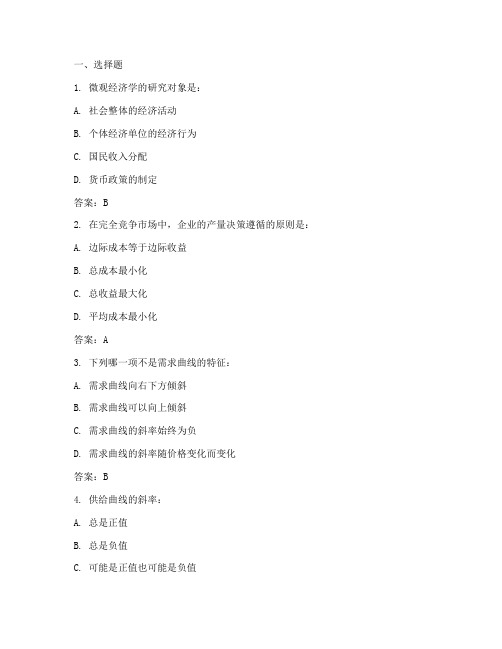
一、选择题1. 微观经济学的研究对象是:A. 社会整体的经济活动B. 个体经济单位的经济行为C. 国民收入分配D. 货币政策的制定答案:B2. 在完全竞争市场中,企业的产量决策遵循的原则是:A. 边际成本等于边际收益B. 总成本最小化C. 总收益最大化D. 平均成本最小化答案:A3. 下列哪一项不是需求曲线的特征:A. 需求曲线向右下方倾斜B. 需求曲线可以向上倾斜C. 需求曲线的斜率始终为负D. 需求曲线的斜率随价格变化而变化答案:B4. 供给曲线的斜率:A. 总是正值B. 总是负值C. 可能是正值也可能是负值D. 随价格变化而变化答案:A5. 效用理论中,消费者在消费过程中追求的是:A. 总效用最大化B. 边际效用最大化C. 总成本最小化D. 边际成本最小化答案:B6. 市场失灵的原因不包括:A. 信息不对称B. 外部性C. 公共物品D. 市场竞争充分答案:D7. 下列哪一项不是博弈论的研究内容:A. 竞争策略B. 合作策略C. 市场需求D. 供给曲线答案:C8. 在完全垄断市场中,企业的边际收益曲线:A. 与需求曲线重合B. 位于需求曲线之上C. 位于需求曲线之下D. 与需求曲线平行答案:C9. 微观经济学中的“无差异曲线”是指:A. 表示消费者偏好的曲线B. 表示生产者成本曲线C. 表示供求均衡曲线D. 表示市场均衡曲线答案:A10. 下列哪一项不是市场效率的表现:A. 资源配置效率B. 产品质量最优C. 市场价格最低D. 信息透明度最高答案:B二、简答题1. 简述微观经济学的研究方法。
答案:微观经济学的研究方法主要包括:(1)边际分析法:通过分析经济变量边际变化对总量的影响,揭示经济现象的规律。
(2)供求分析法:通过分析市场供求关系的变化,研究价格、产量等经济变量的决定。
(3)比较分析法:通过比较不同市场、不同经济主体之间的差异,揭示经济现象的内在联系。
(4)实证分析法:通过收集、整理和分析实际经济数据,验证经济学理论。
微观经济学试题及答案

微观经济学一、单项选择题1. 研究家庭和企业决策的经济学称为()。
A.宏观经济学 B.微观经济学C.实证经济学 D.规范经济学2. 社会经济资源的基本特征是()。
A.经济性 B.有用性C.无限性 D.稀缺性3. 下列问题不属于宏观经济学的是()。
A.货币量变动对通货膨胀的影响 B.企业关于雇用多少工人的决策C.高储蓄对经济增长的影响 D.政府管制对汽车废气的影响4. 当胶卷的价格上升时,照相机的需求量将会()。
A.增加B.减少C.不变D.变化不定5. 以下引起需求变动的因素是()。
A.生产要素价格 B. 生产能力水平B.人们的消费偏好 D. 商品价格水平6. 当茶叶的价格上升时,咖啡的需求量将会()。
A. 增加B. 减少C.不变D.变化不定7. 边际效用是指()。
A. 增加单位商品的消费而增加的平均效用量B. 增加单位商品的消费而增加的总效用量C. 增加单位商品的消费而减少的平均效用量D. 增加单位商品的消费而减少的总效用量8. 一般来说,当消费者沿着同一条无差异曲线增加X物品(用横线代表)的消费量()。
A.每增加1单位X物品就要放弃更多的Y物品B.每增加1单位X物品就要放弃更少的Y物品C.边际替代率递减D.b与c都对9. 第四张比萨饼带来的满足不如第三张比萨饼这一事实是下列哪一个概念的例子。
()A. 消费者剩余B. 总效用递减C. 边际效用递减D. 价值之谜10. 边际报酬递减规律研究的问题是()。
A. 各种生产要素同时变动对产量的影响B. 不同生产要素变动对产量的影响C. 特殊生产要素变动对产量的影响D. 其他生产要素不变,一种生产要素变动对产量的影响11. 在其他生产要素不变的条件下,平均产量曲线与边际产量曲线的交点代表()。
A.总产量达到最大 B. 要素产出效率最高C. 边际产量为零D. 边际产量达到最大12. 劳动对资本的边际替代率衡量()。
A.在保持产量不变时,劳动量增加1单位资本量增加多少B.在保持产量不变时,劳动量增加1单位资本量减少多少C.相对于资本价格的劳动价格D.等成本线的斜率13. 已知产量为100单位时间,总成本为9500元,当产量增加到110单位时,总成本为10000元。
微观经济学考试题库及答案详解
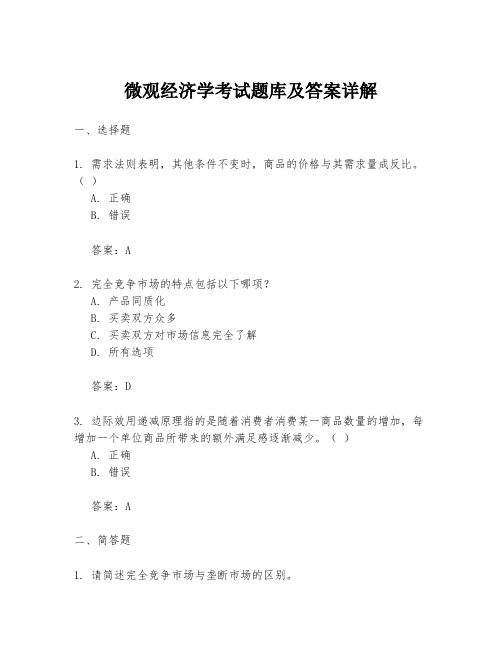
微观经济学考试题库及答案详解一、选择题1. 需求法则表明,其他条件不变时,商品的价格与其需求量成反比。
()A. 正确B. 错误答案:A2. 完全竞争市场的特点包括以下哪项?A. 产品同质化B. 买卖双方众多C. 买卖双方对市场信息完全了解D. 所有选项答案:D3. 边际效用递减原理指的是随着消费者消费某一商品数量的增加,每增加一个单位商品所带来的额外满足感逐渐减少。
()A. 正确B. 错误答案:A二、简答题1. 请简述完全竞争市场与垄断市场的区别。
答案:完全竞争市场与垄断市场的主要区别包括:- 完全竞争市场存在众多买家和卖家,没有单个买家或卖家能够影响市场价格;而垄断市场中,一个卖家控制整个市场,能够影响价格。
- 完全竞争市场中的产品是同质的,没有品牌差异;垄断市场中的产品可能是独特的,具有品牌差异。
- 完全竞争市场中进入和退出市场没有障碍;垄断市场中存在进入障碍,新企业难以进入。
2. 什么是价格弹性?请举例说明。
答案:价格弹性是指需求量或供给量对价格变化的敏感度,用公式表示为:弹性 = (需求量的百分比变化 / 价格的百分比变化)。
例如,如果某种商品的价格上升10%导致需求量下降20%,那么该商品的需求价格弹性为-2,表示为弹性大于1,是弹性较大的商品。
三、计算题1. 假设某商品的需求函数为 \( Q_d = 100 - 5P \),供给函数为\( Q_s = 2P \)。
求市场均衡价格和数量。
答案:市场均衡时,需求量等于供给量,即 \( Q_d = Q_s \)。
\( 100 - 5P = 2P \)\( 100 = 7P \)\( P = 100 / 7 \)将价格 \( P \) 代入需求或供给函数求得数量 \( Q \):\( Q = 2 \times (100 / 7) = 200 / 7 \)四、论述题1. 论述市场失灵的原因及其可能的解决措施。
答案:市场失灵是指市场机制不能有效分配资源的情况。
微观经济学题库选择题带答案

第一章导论1.经济学中的“稀缺性”是指BA.世界上大多数人生活在贫困中B.相对于资源的需求而言,资源总是不足的C.利用资源必须考虑下一代D.世界上的资源终将被人类消耗光2.经济物品是指BCA.有用的物品B.数量有限,要花费代价才能得到的物品C.稀缺的物品D.数量无限,不用付出代价就能得到的物品3.一国的生产可能性曲线以内的点表示CA.生产品最适度水平B.该国可利用的资源减少和技术水平降低C.失业或资源未被充分利用D.通货膨胀4.生产可能曲线的基本原理是AA.假定所有资源得到了充分利用B.一国资源总能被充分利用C.改进技术引起生产可能曲线向内移动D.生产可能曲线上的每一点的产品组合,对该国来说,都是最佳的5.下列那一项最可能导致生产可能性曲线向外移动BA.消费品生产增加,资本品生产减少B.有用性资源增加或技术进步C.通货膨胀;D.失业6.经济学中的基本选择包括的DA.生产什么,生产多少B.怎样生产,何时生产C.为谁生产D.以上都包括7.对某个汽车生产企业来说,下列哪一变量是外生变量CA.汽车的年产量B.生产线的技术水平C.消费者收入增加D.企业的人力资本管理8.下列哪一个变量属于存量(D)A.国民生产总值B.年生产能力C.居民收入D.固定资产价值9.21世纪30年代,西方经济学经历的第二次修改和补充ACD A.出现于1936年B.涉及垄断问题C.代表人物是凯恩斯D.为国家干预经济生活奠定了理论基础1.微观经济学的的基本假设条件是:CA.完全信息的假设B.完全竞争的假设C.合乎理性的人的假设D.边际效用递减的假设2.微观经济学的研究对象包括:ABCA.单个消费者B.单个厂商C.单个市场D.价格理论3.下列几组商品的交叉价格弹性为负向的有:BDA.面粉和大米B.汽油和汽车C.羊肉和牛肉D.CD播放机和CD4.当出租车租金下调后,对公共汽车服务的ACA.需求减少B.需求量增加C.需求曲线左移D.需求无法确定5.粮食市场的需求是缺乏弹性的,当粮食产量因灾害而减少时B A.粮食生产者的收入减少,因粮食产量下降B.粮食生产者的收入增加,因粮食价格会更大幅度上升C.粮食生产者的收入减少,因粮食需求量会大幅度减少D.粮食生产者的收入不变,因粮食价格上升与需求量减少的比率相同6.列商品中,需求价格弹性最大的是CA.服装B.化妆品C.金银首饰D.食盐7.某一时期,电冰箱的供给曲线向右移动的原因可以是BA.电冰箱的价格下降B.生产者对电冰箱的预期价格上升C.生产冰箱的要素成本上升D.消费者的收入上升8.食盐市场的需求是缺乏弹性的,由于某种非价格因素的影响使食盐产量下降20%,在这种情况下 CA.食盐生产者的收入减少,因为食盐产量下降20%B.食盐生产者的收入增加,因为食盐价格上升低于20%C.食盐生产者的收入增加,因为食盐价格上升超过20%D.食盐生产者的收入不变,因为食盐价格上升等于20%9.影响一种商品需求数量的因素包括ABCDA.商品本身的价格B.消费者的收入水平C.相关商品的价格D.消费者的偏好10.消费者预期某物品未来价格要上升,则对该物品的当前需求会BA.减少B.增加C.不变D.以上三种情况都有可能11.如果商品A和商品B是替代品,则A的价格下降将造成DA.A的需求曲线向右移动B.A的需求曲线向左移动C.B的需求曲线向右移动D.B的需求曲线向左移动12.若某行业中许多生产者生产一种标准化产品,我们可估计到其中任何一个生产者产品的需求将是DA.毫无弹性B.有单位弹性C.缺乏弹性或弹性较小D.富有弹性或弹性很大13.假如生产某种产品所需原料价格上升了,则这种商品BA.需求曲线向左移动B.供给曲线向左移动C.需求曲线向右移动D.供给曲线向右移动14.如果人们收入水平提高,则食品支出在总支出中的比重BA.提高B.降低C.不变D.不确定15.厂商在工资率下降的时候一般倾向于增雇工人,如果对工人的需求缺乏弹性,工资率下降将导致工资总额AA.减少B.不变C.增加D.无法确定16.政府为了扶持农业,对农产品规定了高于均衡价格的支持价格。
- 1、下载文档前请自行甄别文档内容的完整性,平台不提供额外的编辑、内容补充、找答案等附加服务。
- 2、"仅部分预览"的文档,不可在线预览部分如存在完整性等问题,可反馈申请退款(可完整预览的文档不适用该条件!)。
- 3、如文档侵犯您的权益,请联系客服反馈,我们会尽快为您处理(人工客服工作时间:9:00-18:30)。
1. The scientific method is not applicable to the study of economics because economics is not a true science.A) TrueB) False2. Hypotheses derived from economic analysis can be validated through empirical analysis, but hardly ever with absolute certainty.A) TrueB) False3. Which of the following statements relates to the concept of efficiency?A) The absence of waste.B) Using resources as effectively as possible.C) Being able to produce more of one good only by producing less of something else.D) All the above.E) b. and c. only.Use the following to answer question 4:Figure 14. Figure 1 displays the production-possibilities of two countries. Given that both countries produce five units of x, which of the following best describes country B's production of y?A) Less than country A's production of y.B) The same as country A's production of y.C) More than country A's production of y.D) Cannot be determined from the graph.E) None of the above.5. Mass unemployment of resources means society operates inside its production-possibility frontier.A) TrueB) False6. If two goods use the same resources and the same technology, the production possibilities curve between the two goods will have a positive slope.A) TrueB) False7. It is scarcity that makes goods economic goods.A) TrueB) False8. Which of the following is the most basic of the subjects with which the study of economics must try to deal?A) Markets.B) Money.C) Profit seeking.D) The price mechanism.E) Scarcity.9. Poor money management by the government, aside from increasing the unemployment rate, will have a relatively small effect on the economy.A) TrueB) FalseUse the following to answer question 10:Figure 210. In Figure 2, what is Country B's cost of producing 1 unit of x in terms of y?A) 10 units of y.B) 1/2 units of y.C) 5 units of y.D) 2 units of y.E) None of the above.11. Barter is inconvenient because:A) bargaining power is unequal between rich and poor.B) without money, who can define "fair" values?C) my wants and supplies do not match your supplies and wants.D) it leads to imperfect competition.E) all of the above.12. The economic role of government in mixed economies can include:A) provision of public goods.B) tax collections.C) income redistribution.D) all of the above.E) none of the above.13. By the "invisible hand," Smith meant the influence and lobbying of the hidden interest groups.A) TrueB) False14. A society which forgoes present consumption:A) is forced to do so because of excessive consumption within the country in the past.B) may be devoting new resources to new capital formation.C) is merely devoting resources to the replacement of capital.D) expects to consume only that amount tomorrow which was foregone today.E) does none of the above.15. An economic good is valued in part by its scarcity.A) TrueB) False16. The statement that roundabout methods of production are often more efficient than more direct methods:A) means that roundabout methods use the same inputs as more direct methods, except for time, which is not a scarce economic good.B) means that consumers ought to choose those goods which most lend themselves to roundabout methods of production.C) means that the most roundabout method is always the most efficient method of producing any output.D) is false, for direct and indirect methods of production are usually the same in terms of efficiency.E) suggests that foregone consumption devoted to investment sometimes increases future output in ways that more closely match individual and/or social desires.17. Which of the following statements is true of specialization?A) Specialization is inconsistent with the idea of individual freedom.B) Economies that practice a division of labor are morally superior to those that do not.C) In accepting specialization, a person sacrifices his or her own interests for the sake of society's interest.D) While specialization has enormous advantages, the costs outweigh them.E) Increased productivity is more likely to be achieved through specialization.18. In an affluent modern society, businesses may have to offer workers more fulfilling jobs.A) TrueB) False19. Consumers vote their dollars primarily in:A) labor markets.B) land markets.C) capital markets.D) goods markets .E) none of the above.20. An example of legal limitations on property rights is the prohibition of pollution.A) TrueB) False21. Lower prices coax out higher quantities demanded along a downward-sloping demand curve.A) TrueB) False22. An increase in price will lead to a lower quantity demanded because:A) suppliers will supply only the smaller amount.B) quality deteriorates.C) people will purchase less of the good.D) all of the above.E) none of the above.Use the following to answer question 23:Figure 323.Let P* and Q* represent market clearing price and quantity, respectively. Given the supply and demand curves drawn in Figure 3, a reduction in the price of an input used in the production of Q can be expected to cause:A) P* and Q* to climb.B) P* to climb while Q* falls.C) P* to climb while Q* holds steady.D) P* to fall while Q* climbs.E) P* and Q* to fall.Use the following to answer question 24:Table 1The Market for Potato Chips(quantities measured in bags per week)Price Quantity Supplied Quantity Demanded$1.00 500 20002.00 1000 17503.00 1500 15004.00 2000 12505.00 2500 100024. According to T able 1, the equilibrium price for potato chips is:A) $1.00.B) $2.00.C) $2.50.D) $3.00.E) $4.00.25. Upward-sloping supply curves are the result of:A) increasing returns to scale.B) increasing costs of production.C) changes in government policies.D) changes in technology.E) none of the above26. To say that a price "clears the market" is to say that everyone who wants that commodity is getting all they want.A) TrueB) False27. The position of the supply schedule for American-made cars will not be directly affected by which of the following?A) Union wage rates.B) Car prices.C) The possibility of strikes.D) A change in assembly technology.E) All of the above will affect supply.28. The demand curve for a normal good will shift to the right if:A) income increases.B) population increases.C) the price of a substitute good increases.D) all the above.E) none of the above.29. Given a fixed supply of lamb chops, a reduction in the price of pork chops (close substitutes) will tend to: (这类题比容易出)A) shift the demand curve for lamb chops to the right.B) shift the demand curve for pork chops to the right.C) shift the demand curve for pork chops to the left.D) raise the price of lamb chops.E) lower the price of lamb chops.30. One reason that supply curves display positive slope is that:A) expanded production may require the use of superior resources.B) people are not willing to pay a higher price for more goods.C) expanded industry output might cause a labor shortage and subsequently increase the wage rate included in the cost of production.D) extra production brings in the more efficient, lower-cost producers.E) the law of diminishing returns is important to producers.31. If a 1 percent change in price causes a 5 percent change in quantity demanded, then demand is price inelastic.A) TrueB) False32. Whenever total expenditure (i.e., total revenue) remains the same aftera change in price, the elasticity of demand is:A) greater than 1.B) less than 1.C) equal to 0.D) equal to 1.E) equal to infinity.33. If price and quantity sold both decrease from one period to another, we may infer that the law of downward-sloping demand does not operate in that market.A) TrueB) False(重要)34. In "tight" housing markets, rent controls are often applied to hold the price of housing to a "reasonable" level. What is the immediate effect of this price policy with respect to the allocative functions of prices, and the relative incomes of tenants and landlords?A) The allocative function of prices is impaired, but the tenants are prevented from gaining at the expense of the landlords.B) The allocative function of prices is not impaired, and the tenants are prevented from gaining at the expense of landlords.C) The allocative function of prices is impaired, and the tenants who find housing gain at the expense of landlords.D) The allocative function of prices is not impaired, but the landlords gain at the expense of tenants who do not find housing.E) None of the above.35. Which of the following inefficiencies might be the result of monopoly power's destroying a competitive equilibrium?A) Prices too high.B) Output too low.C) Wages distorted across the economy.D) Input prices distorted across the economy.E) All of the above.36. Dollar receipts for sellers of some commodities will be lower at higher prices.A) TrueB) False37. The quantity of a good which a person will purchase will not depend on which one of the following items? xA) The price of the good.B) His or her tastes.C) The prices of substitute goods.D) His or her income.E) The elasticity of supply.Use the following to answer question 38:Figure 438. Refer to Figure 4 once again. Suppose that now the demand curve has shifted to D'D'. At what point along D'D' is price elasticity equal to 1?A) GB) between G and H.C) H.D) between H and I.E) I.39. Rank the supply curves in the figure below in order of greatest to least price elasticity at the common intersection point.A) C, A, B.B) B, A, C.C) B, C, A.D) A, B, C.E) None of the above.40. A price subsidy of 20 cents per gallon on milk (which does not have a totally inelastic demand curve) will result in a:A) change in consumer tastes.B) drop in the equilibrium price of 20 cents per gallon.C) drop in the equilibrium price of less than 20 cents per gallon.D) drop in the equilibrium price of more than 20 cents per gallon.41. The law of diminishing marginal utility states that the:A) ratio of MU to P for luxuries is lower than that for necessities.B) utility derived from the last unit of the good consumed falls as the consumption of the good increases.C) ratio of MU to P will be the same for all goods.D) utility derived from total consumption of a good falls as consumption increases.E) none of the above.42. A consumer is said to be in equilibrium in his or her choice between two goods A and B when:A) the purchase of good A gives the same satisfaction as the purchase of good B.B) the last purchase of good A gives the same addition to satisfaction as the last purchase of good B.C) each penny spent on good A gives the same satisfaction as each penny spent on good B.D) the last penny spent on good A gives the same addition to satisfaction as the last penny spent on good B.E) the last pennies spent on goods A and B generate no additions to satisfaction.43. A consumer spends all of her income on two goods, coffee and doughnuts. She purchases coffee at 25 cents a unit with a total utility of 800 and a marginal utility of 12. Doughnuts are purchase at 75 cents a unit with a total utility of 200 and a marginal utility of 24. In order to reach consumer equilibrium, she should consume:A) less doughnuts and more coffee.B) more doughnuts but the same amount of coffee.C) more coffee but the same amount of doughnuts.D) more doughnuts and less coffee.E) the same amount of coffee and doughnuts.44. If a person only consumes pickles and peanut butter, he will consume peanut butter up to the point where the:A) marginal utility of the last unit of peanut butter consumed equals that of the last unit of pickles consumed.B) total utility of peanut butter consumed equals the total utility of pickles consumed.C) consumer surplus of peanut butter consumption equals the consumer surplus of pickle consumption.D) last dollar spent on peanut butter consumption provides the samemarginal utility as the last dollar spent on pickle consumption.E) none of the above.45. Water tends to have a low marginal utility because substitutes for it are widely available.A) TrueB) False46. A good which sells for a higher price than one which is more important for welfare reflects the concept of:A) complementarity in demand.B) substitution.C) marginal or total utility.D) the paradox of value.E) law of diminishing marginal utility.47. The price of good X is $1.50 and that of good Y, $1. A particular consumer who evaluates the marginal utility of Y to be 30 units, and is in equilibrium with respect to purchases of X and Y, must consider the marginal utility of X to be:A) 15 units.B) 20 units.C) 30 units.D) 45 units.E) none of the above.48. It is possible to sum individual demand curves to get the market demand curve only when all consumers are exactly alike in their demands.A) TrueB) False49. The paradox of value is not the result of declining marginal utility.A) TrueB) False50. In the figure below, which area represents consumer surplus at a price of 5?A) OADC.B) OBEC.C) CEH.D) OBEH.E) CEGF.51. Both in number and in dollar value of sales, the individual proprietorship is the dominant form of American enterprise.A) TrueB) FalseUse the following to answer question 52:Figure 552. Suppose that two inputs, K and L, are variable and increase at the same rate. Which one of the panels in Figure 5 represents Increasing Return to Scale (IRS)?A) Panel a.B) Panel b.C) Panel c.D) Panel d.E) None of the above.53. "Unlimited liability" in partnerships refers to the liability of each partner for her percentage share of any losses incurred, without limit, except for some legal minimum of property she is permitted to keep.A) TrueB) False54. The employment of which of the following inputs might be adjusted in the short run?A) Physical capital.B) Number of hours worked by labor.C) Units of energy required per unit output.D) Units of material required per unit output.E) None of the above.55. Numerically, the bulk of businesses in the U.S. are:A) corporations.B) partnerships.C) sole proprietorships.D) farms.E) mom-and-pop retail shops.56. If incomes were properly distributed, competitive general equilibrium would move resources to the best use for consumers' satisfaction.A) TrueB) FalseUse the following to answer questions 57:Total Product withVarious Input CombinationsLabor Land 10 15 200 0 0 01 20 20.67 20.52 38 39.33 40.03 54 57.00 58.54 68 72.67 76.05 80 87.33 92.56 90 102.00 108.057. Suppose that production were defined by the function recorded in the table above. For diminishing returns to continue to hold for the 7th unit of labor with land equal to 15 units, total product for the combination of [labor =7; land = 15] would have to be less than:A) 0.B) 116.67.C) 115.67.D) 114.67.E) none of the above.Use the following to answer questions 58-59:Table 2Total Product withVarious Input CombinationsLandLabor 10 15 200 0 0 01 20 20.67 20.52 38 39.33 40.03 54 57.00 58.54 68 72.67 76.05 80 87.33 92.56 90 102.00 108.058. The production process defined by the function recorded in Table 2 displays diminishing returns in both labor and land.A) TrueB) False59. The production process defined by the function recorded in Table 2 displays decreasing returns to scale for labor but not for land.A) TrueB) False60. Which of the following is an example of a project that could be observed in the short run?A) The construction of a new assembly line to match an existing one.B) The construction of a new assembly line to take advantage of a new technology.C) The moving of an established assembly line to bring it geographically closer to a market.D) The sale of an existing assembly line on the scrap market to finance part of a new facility.E) None of the above.61. Horizontal long-run MC is associated with constant returns to scale.A) TrueB) False62. A fixed cost is:A) the cost of any input whose per-unit price has been fixed, whether by long-term contract or by some similar means.B) a cost whose increases are exactly proportional to increases in output.C) any component included in average cost which enters in AC as the same fixed per-unit amount, no matter what the level of plant output may be.D) a cost which the firm would incur even if its output were zero.E) none of the above.Use the following to answer questions 63-64:Table 3Quantity Variable Cost Total Cost1 25 402 45 603 60 754 70 855 85 1006 105 1207 132 14763. What is MC between Q = 3 and Q = 4 in Table 3?A) 10B) 15C) 20D) 25E) None of the above.64. What is AFC at Q = 5 in T able 3?A) 3B) 4C) 5D) 7.5E) 1565. Total cost at q + 1 minus total cost at q gives marginal cost for the qth unit.A) TrueB) False66. The balance sheet always balances because:A) by definition, profit is the residual between revenue and cost.B) every proper official business statement is audited by a firm of independent accountants.C) accountants, like statisticians, know how to manipulate the truth.D) by definition, net worth equals the difference between assets andliabilities.E) none of the above.67. A driver wishes to buy gasoline and have her car washed. She finds that the wash costs $3.00 when she buys 19 gallons at $1.00 each, but that if she buys 20 gallons, the car wash is free. Thus the marginal cost of the twentieth gallon of gas is:A) –$2.00.B) $0.00.C) $1.00.D) $2.00.E) none of the above.68. If a firm produces more goods than it sells and buys more raw materials than it uses up during the year, an inventory adjustment must be made so as not to:A) overstate earnings for the year.B) understate earnings for the year.C) overstate liabilities at the end of the year.D) understate liabilitiesg at the end of the year.E) overstate assets at the end of the year.69. Both the balance sheet and the income statement indicate the flow of sales, cost, and revenue over the accounting period.A) TrueB) False70. In calculating a firm's total costs, which of the following is not included?A) The owner's expertise.B) The demand curve facing the firm.C) The taxes paid by the firm.D) Non-essential costs, such as advertising and entertainment expenses.E) Input prices.71. The zero-profit point for a perfectly competitive firm occurs where the price equals the minimum point of the:A) AVC curve.B) AC curve.C) MC curve.D) AFC curve.E) none of the above.72. In the long run, all costs:A) lie along a perfectly elastic long-run supply curve.B) are fixed costs.C) are variable costs.D) exhibit constant returns to scale.E) depend upon the demand structure of the given market.73. Pure economic rent is the price paid to a factor of production that is fixed in total supplyA) TrueB) False74. If, in long run equilibrium, the competitive price of some good is $16.67, then, for each and every firm in the industry,A) marginal cost > average cost = $16.67.B) marginal cost < average cost = $16.67.C) $16.67 = marginal cost = average cost.D) $16.67 = marginal cost > average cost.E) $16.67 = marginal cost < average cost.75. A tax on the emission of a pollutant from the firms of a competitive industry can be expected to cause the equilibrium quantity demanded and supplied to decline.A) TrueB) False76. In a market economy, the short-run reaction to an excess supply of a commodity after a decrease in demand is:A) price will rise, but profits fall.B) price and profits will fall.C) price will fall, but profits will be unchanged.D) price will fall, but profits will increase.E) price and profits will both increase.77. In the long run, any firm will eventually leave an industry if:A) price does not cover at least average total cost.B) price is not equal to marginal cost.C) price is higher than average variable cost.D) price is not at least equal to the minimum of the marginal cost curve.E) other firms in the industry are leaving.Use the following to answer question 78:Figure 678. In Figure 6, the firm's economic profits will equal:A) 0.B) $40.C) $100.D) $150.E) none of the above.79. Which of the following is incompatible with an efficient economic optimum?A) Perfect competition.B) Absence of externalities.C) Monopoly.D) All of the above are incompatible.E) None of the above is incompatible.80. Under conditions of decreasing cost:A) externalities are irrelevant and inapplicable.B) each of the firms in the industry will continue to produce more output at falling costs per unit.C) a strong case can be made for supplanting complete individualism by some kind of group action.D) a few large sellers may come to dominate the industry.E) monopolization of the industry becomes impossible.Use the following to answer questions 81-82:Table 4P Q$5 8$4 12$3 17$2 22$1 2781. Suppose an imperfect competitor faces the demand curve defined in Table 4, and its MC is constant at $2.00. If the firm is able to produce at any output level, then it maximizes profits at:A) P = 5; q = 8B) P = 4; q = 12.C) P = 3; q = 17.D) P = 2; q = 22.E) none of the above if fixed costs are less than $1.00.82. Consider the demand curve given in T able 4. If the imperfectly competitive firm is able to produce at any output level, then the price and quantity which maximize total revenue are:A) P = 5; q = 8B) P = 4; q = 12.C) P = 3; q = 17.D) P = 2; q = 22.E) P = 1; q = 27.83. Falling marginal revenue facing an individual firm is incompatible with:A) growth of the firm.B) perfect competition.C) oligopoly.D) barriers to entry.E) none of the above.(迷惑)84. A percentage tax on a monopolist's profit has no effect on the profit-maximizing output as long as the tax is no greater than 100%.A) TrueB) False85. A profit-maximizing firm will always try to operate at the level of output at which its average costs are at a minimum, i.e., at the bottom of its U-shaped cost curve.A) TrueB) False86. Steel is an oligopolistic industry in the U.S.A) TrueB) False87. If all firms in an industry sell identical products, then it would never pay to advertise.A) TrueB) False88. The marginal cost schedule facing an imperfect competitor is constant at $12. The demand curve is given in Table 5. The profit maximizing output for this firm is:Table 5P Q$20 6$19 7$18 8$17 9$16 l0A) 6 unitsB) 7 unitsC) 8 unitsD) 9 unitsE) 10 units89. If a firm's demand curve is horizontal, then the firm's marginal revenue is:A) less than the price of the product.B) equal to the price of the product.C) greater than the price of the product.D) greater than, equal to, or less than the price of the product, depending on the particular circumstances.E) not determinable from the above information.90. An imperfect competitor is not willing to increase sales at the prevailing price because to do so would reduce marginal revenue. (价格不能保持)A) TrueB) False91. If price equals P1 for a monopolist good and P2 for a competitive good, then for any single consumer the ratio of marginal utilities, MU1/MU2: (等边际)A) is exactly 1, and equal to the ratios of marginal costs, MC1/MC2.B) is exactly 1, and less than the ratios of marginal costs, MC1/MC2.C) is exactly 1, and greater than the ratios of marginal costs, MC1/MC2.D) is exactly 1, and MC1 = MC2E) cannot be determined on data given.Use the following to answer questions 92-93:Figure 792. By the deadweight loss due to monopoly, we mean the area in Figure 7 labeled:A) PAB.B) ABCD.C) FDEQ.D) PCEB.E) BDE.93. Consider Figure 7. The cartel solution would occur at point:A) B.B) E.C) H.D) G.E) none of the above.94. The "separation of ownership and control" in the large corporation refers primarily to:A) government limitations on the rights of capital ownership.B) the ability of a small minority of shareholders or management to exercise effective control.C) the issuance of voting warrants to management personnel.D) the lack of diversification of stock ownership.E) the fact that an officer of the company can sit on the board of directors, even though he may not be a shareholder.95. "There are thousands of 'Ma and Pa' grocery stores in the United States that sell very similar merchandise. Therefore, the retail grocery business must be perfectly competitive." This statement is:A) correct; grocery stores are like wheat farms, and if wheat farming is perfectly competitive, so is the grocery business.B) incorrect; since the production of food is nearly perfectly competitive, the distribution of food must be perfectly competitive also.C) incorrect; grocery stores are best described as oligopolistic.D) incorrect; the thousands of separate retail grocery markets may best be described as monopolistically competitive with product differentiation determined by location.E) correct; retail groceries are notoriously unprofitable.96. A concentration ratio measures:A) the number of firms in a perfectly competitive industry.B) the number of products sold in a monopolistically competitive market.C) the ratio of the total number of firms in the market to the dollar value of industry revenues.D) the percent of total industry output that is accounted for by the largest firms.E) none of the above.97. Monopolistic deviation from P = MC means that:A) nobody can be made better off without making someone else worse off.B) goods are being produced efficiently.C) society is more able to achieve its welfare optimum.D) someone can be made better off without making someone else worse off.E) none of the above.98. Which of the following best explains why collusive oligopolies are not stable?A) Companies are inherently hostile to each other.B) Companies feel they have a moral responsibility not to collude.C) Each company in the oligopoly can increase its profits by deviating from the agreed upon price and/or quantity.D) Oligopolies are not unstable; rather they are quite stable.E) None of the above.99. Many firms practice mark up pricing, since it allows for profit maximization.A) TrueB) False100. Strategic interaction is a term used to describe the condition in which a firm's business strategy depends upon its competitors' actions.A) TrueB) False。
